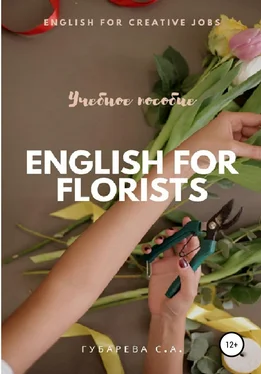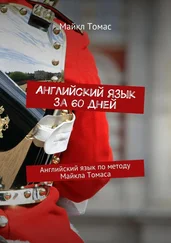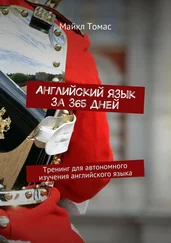Светлана Губарева
Английский язык для флористов
Foreword / Предисловие
Данное учебное пособие предназначено для начинающих и практикующих флористов с языковым уровнем В1.
Цель – обеспечение флористов лексическим минимумом, необходимым для понимания терминологии, принятой в профессиональной среде на международном уровне, чтения и перевода текстов флористической тематики, пополнения активного словарного запаса для выработки коммуникативных навыков и успешных коммуникаций в международных обществах флористов.
Лексический текстовый материал представлен аутентичными текстами, заимствованными с англоязычных сайтов. Каждый раздел сопровождается списком использованных источников и ссылками на веб-страницы организаций и блоги. Упражнения предполагают как индивидуальную, так и парную/групповую аудиторную работу.
Памятка для самостоятельной работы:
Выполняйте задания в юнитах по порядку;
Внимательно читайте формулировки задания;
Ответы на тренировочные задания стоит смотреть после того, как задание полностью сделано;
При возникновении трудностей грамматического или лексического характера проанализируйте ответы и перечитайте правила. Это поможет в дальнейшем не допускать ошибок;
Используйте рефлексивный блок Now you know после прохождения юнита (отмечайте, какие пункты вы поняли и изучили), чтобы понимать, на каком этапе Вы остановились;
По прохождению всех юнитов сделайте итоговый тест. При возникновении сложностей с лексикой или грамматикой – вернитесь в соответствующий юнит для повторения.
Unit 1 Historical Overview

1. Read the following proverbs about flowers and use phrases from the table to express your opinion:
The flowers in your garden don’t smell as sweet as those in the wild, but they last much longer.
~ Chinese Proverb
Each day you can admire the moon, the snow and the flowers.
~ Japanese Proverb

2. Read the following definition of floristry and write down your own:
Floristry– the branch of botany concerned with the types, numbers, and distribution of plant species in a particular area.
___________________________________________
___________________________________________
3. Read the text and match words with the pictures:
Cultural significance
Flowers have been symbols of beauty in most civilizations of the world, and flower giving is still among the most popular of social amenities. As gifts, flowers serve as expressions of affection for spouses, other family members, and friends; as decorations at weddings and other ceremonies; as tokens of respect for the deceased; as cheering gifts to the bedridden; and as expressions of thanks or appreciation. Most flowers bought by the public are grown in commercial greenhouses or horticultural fields and then sold through wholesalers to retail florists.
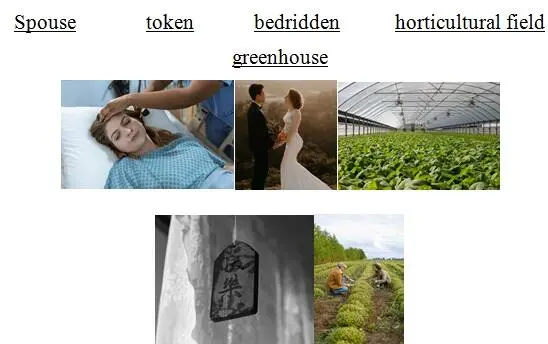
4. Read the text about the history of floristry and complete the table:
Throughout the history of art, certain subjects have resonated particularly strongly with artists and audiences alike. Ranging from cats to Cupid, these revisited trends reveal art's most popular muses, with flowers at the forefront.
Rooted in ancient art and still prevalent today, depictions of blossoms, blooms, and other botanical elements can be found in many of the most significant art movements, whether carved into clay or starring in a still-life. Here, we trace the history of the humble flower in art, exploring its evolution and identifying iconographic trends that have attracted artists for centuries.
Ancient Egypt
In Ancient Egyptian mythology, the lotus flower symbolized the sun and had strong ties to the concept of creation and rebirth. A simplified and stylized lotus motif was often used to adorn artistic objects, including papyrus paintings, amulets, and ceramics.
In addition to ornamental decorations, Egyptians also employed flowers as an artistic medium. In King Tutankhamun's tomb, for example, multiple collar necklaces made of dyed linen and cut blossoms—including sunflowers, cornflowers, poppies, and blue lotuses—were found among his many trinkets and treasures.
Medieval Art
Floral motifs were also prominent in decorative art of the Middle Ages. During this period, tapestries and other large-scale textile art gained popularity, popping up in castles and churches across Europe. In many of these works, the subject—often a group of figures—is placed against a backdrop embellished with repeating floral patterns. These pieces are known as millefleur (from the French mille-fleurs , or “thousand flowers”) tapestries.
The Renaissance
During the Italian Renaissance, artists were inspired by millefleur tapestries and often incorporated floral designs into their large-scale mythological paintings. In Primavera by Botticelli, the goddess of Spring is shown sprinkling flowers on the blossom-covered forest floor, which make up most of the 190 blooms featured in the painting.
At this time, many Renaissance artists in Northern Europe specialized in still-life painting. Often, these depictions featured floral arrangements that, according to the Metropolitan Museum of Art, “typically combined flowers from different countries and even different continents in one vase and at one moment of blooming,” illustrating the importance and prevalence of botanical books and other floral studies during the Northern Renaissance.
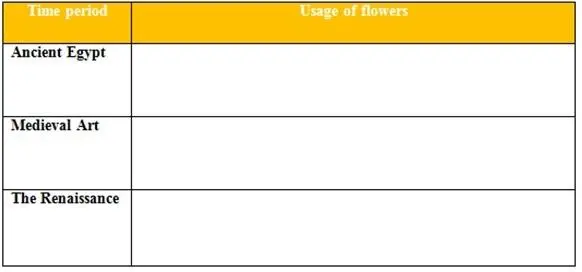
5. Match the words from the text with their definitions: 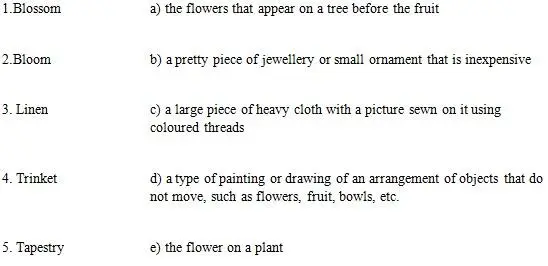

6. Math the names of flowers with the photos:
Читать дальше
